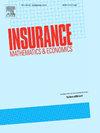Portfolio benchmarks in defined contribution pension plan management
IF 2.2
2区 经济学
Q2 ECONOMICS
引用次数: 0
Abstract
In financial practice, a portfolio benchmark is of importance as it characterizes the fluctuation of the market and better evaluates the performance of the fund manager. We study the optimal investment problem of Defined Contribution (DC) pension plan management with portfolio benchmarks. As such, three technical difficulties arise, and we overcome them accordingly. First, the classic Legendre transformation cannot handle the stochastic nature of the portfolio benchmark. We introduce a parameterized Legendre transformation technique and conduct it to obtain closed-form optimal control strategies. Second, we discover that the optimal solution is not unique when the drift parameter of the benchmark is exactly Merton's constant. We employ a risk management criterion minimizing the liquidation probability to further select a “best” control strategy among the optimums. Third, the Lagrange multiplier cannot be directly solved from the budget constraint. We propose a new numerical technique called the Monte Carlo bisection method to solve it. Therefore, we can analyze the optimal strategies with asymptotic analysis and demonstrate financial insights. We find that when the benchmark is deterministic or its drift is low, the optimal investment aligns with the literature, while the high-drift benchmarks lead to an opposite risk behavior. Finally, empirical validation using the US and Chinese market data shows that our strategy is more effective in a lower risk-premium market.
固定缴费养老金计划管理中的投资组合基准
在金融实践中,投资组合基准很重要,因为它可以表征市场的波动,更好地评估基金经理的业绩。研究了具有投资组合基准的养老金计划管理的最优投资问题。因此,出现了三个技术困难,我们相应地克服了它们。首先,经典的勒让德变换不能处理投资组合基准的随机性。引入了一种参数化的勒让德变换技术,并将其应用于闭环最优控制策略。其次,我们发现当基准的漂移参数恰好是默顿常数时,最优解是不唯一的。我们采用最小化清算概率的风险管理准则,进一步在最优控制策略中选择“最佳”控制策略。第三,拉格朗日乘数不能直接从预算约束中求解。本文提出了一种新的数值求解方法——蒙特卡罗二分法。因此,我们可以用渐近分析来分析最优策略,并展示财务洞察力。我们发现,当基准是确定性的或其漂移较低时,最优投资与文献一致,而高漂移基准导致相反的风险行为。最后,利用美国和中国市场数据进行的实证验证表明,我们的策略在风险溢价较低的市场中更为有效。
本文章由计算机程序翻译,如有差异,请以英文原文为准。
求助全文
约1分钟内获得全文
求助全文
来源期刊

Insurance Mathematics & Economics
管理科学-数学跨学科应用
CiteScore
3.40
自引率
15.80%
发文量
90
审稿时长
17.3 weeks
期刊介绍:
Insurance: Mathematics and Economics publishes leading research spanning all fields of actuarial science research. It appears six times per year and is the largest journal in actuarial science research around the world.
Insurance: Mathematics and Economics is an international academic journal that aims to strengthen the communication between individuals and groups who develop and apply research results in actuarial science. The journal feels a particular obligation to facilitate closer cooperation between those who conduct research in insurance mathematics and quantitative insurance economics, and practicing actuaries who are interested in the implementation of the results. To this purpose, Insurance: Mathematics and Economics publishes high-quality articles of broad international interest, concerned with either the theory of insurance mathematics and quantitative insurance economics or the inventive application of it, including empirical or experimental results. Articles that combine several of these aspects are particularly considered.
 求助内容:
求助内容: 应助结果提醒方式:
应助结果提醒方式:


